The moon in your night sky may not fizz and bubble like this fizzy paint moon craft, but it’s still a fun way to dig into astronomy, chemistry, and art all at the same time! Let’s get into a cool STEAM project with our favorite chemical reaction, baking soda, and vinegar.
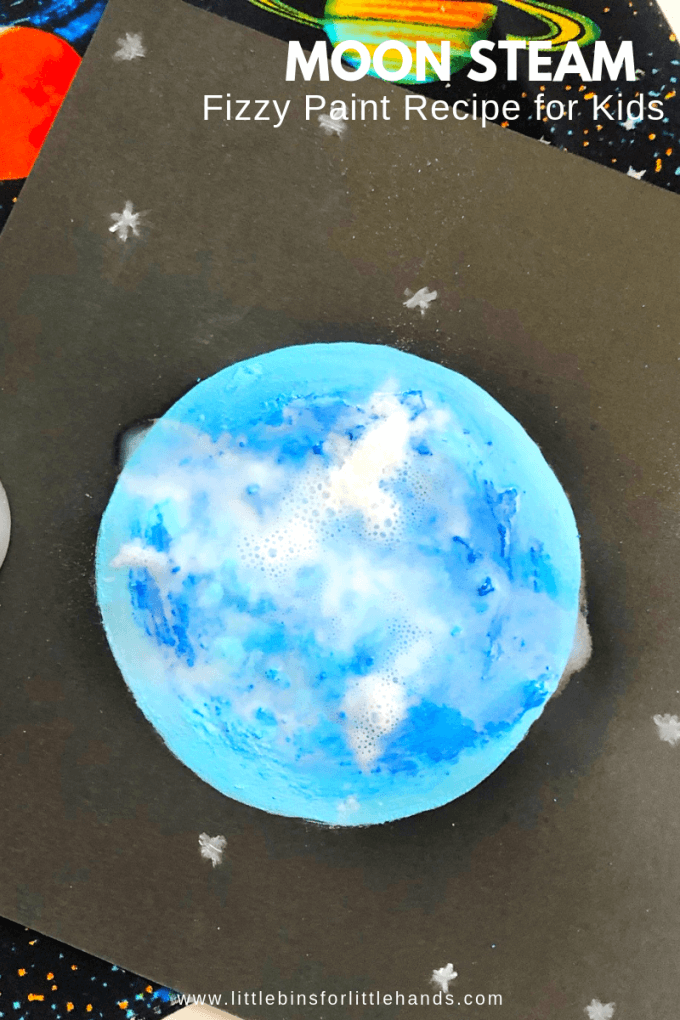
Let’s whip up a batch of fizzing baking soda paint and use the opportunity to learn about the different phases of the moon and what causes us to see only part of the moon! This fun moon craft lets kids get creative and learn some simple astronomy in the process. While you’re at it, make sure to check out these other fun space activities.
Tips For Setting Up This Moon Activity
- You do want to make sure the baking soda paint is on the thicker side when you mix the ingredients together. Generally a 1:1 ratio is good.
- Also, make sure to spread the paint on in a thick layer for best fizzy results.
- Additionally, you want to make sure your masterpiece moon is dry before working with the vinegar.
- Extend this Moon theme STEAM activity by cutting out the different shapes for the phases of the Moon and painting them with the baking soda paint as well. You can read a full description here… phases of the moon.
Fizzy Paint Moon Craft
Add this printable moon theme activity pack to help learn about the moon phases, too!
Supplies:
- Black card stock or heavyweight paper
- Baking Soda
- Vinegar
- Spray bottle or pipette
- Craft Paint
- Cups and mixing utensils
- Paintbrushes
TIP: While you have the baking soda out, make these fizzing moon rocks for moon theme science and STEM!
Instructions:
STEP 1: Start with making the baking soda paint. Fill up a small spray bottle with vinegar and set aside.
STEP 2: In a few separate cups, mix a 1/2 tablespoon of paint with a tablespoon of baking soda.
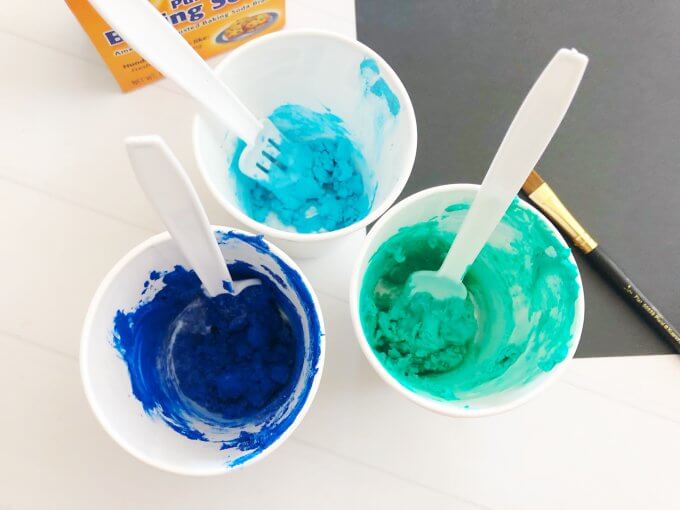
STEP 3: Draw a circle on a piece of black card stock to represent the moon.
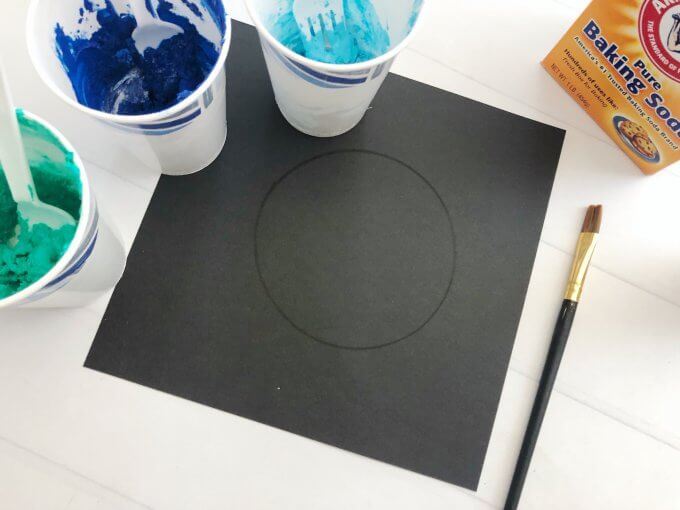
STEP 4: Use the paint brushes to paint the Moon with different shades of blue baking soda paint (the paint should be thick). Let your Moon dry and draw a few stars around it with a white crayon or marker.
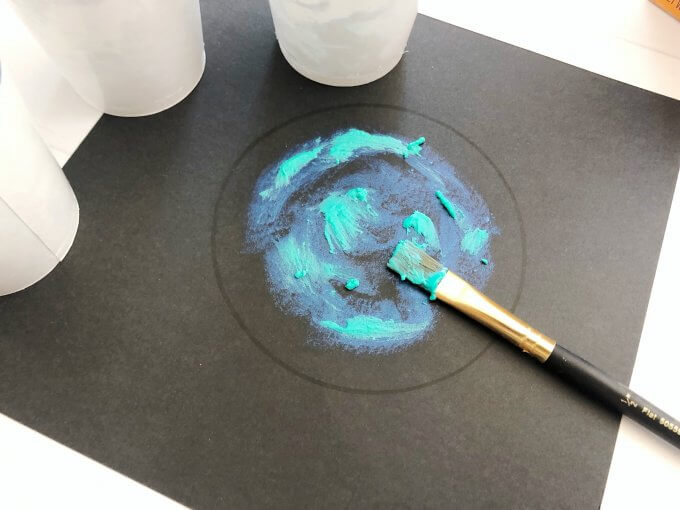
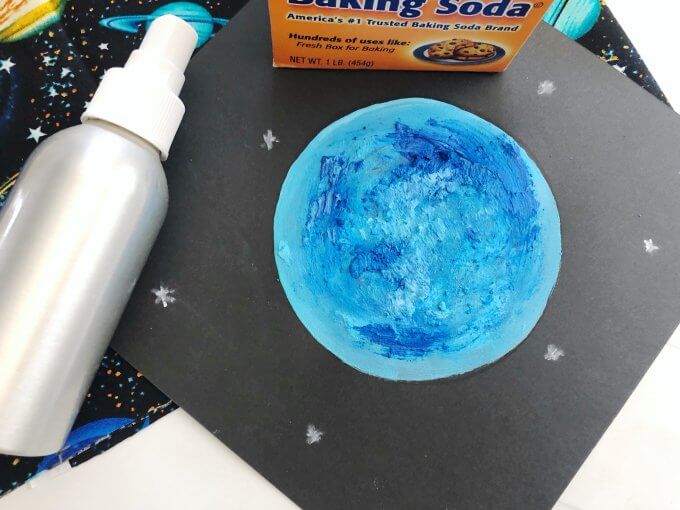
STEP 5: Once the moon painting is completely dry, use the spray bottle to squirt vinegar onto it and watch it fizz.
TIP: Go ahead and make a whole solar system of fizzy Moons, planets, stars, and sun!
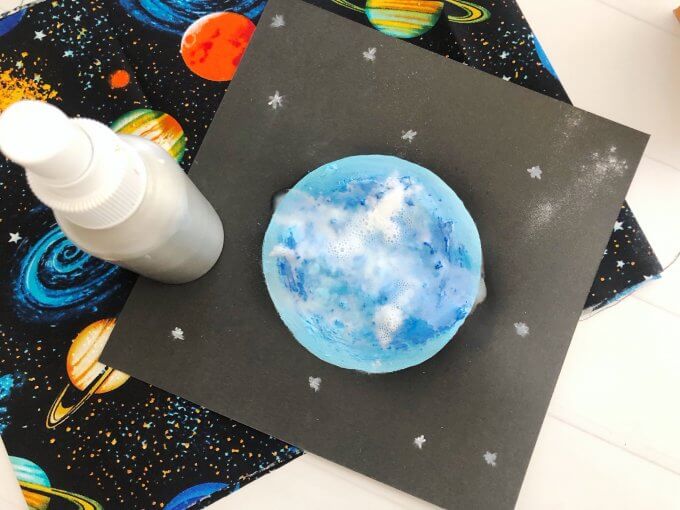
The Science of Baking Soda Paint
The science behind this fizzing moon craft is the chemical reaction that occurs between the baking soda and the vinegar!
Baking soda is a base, and vinegar is an acid. When the two combine, they make a gas called carbon dioxide. You can hear the fizz, see the bubbles, and even feel the fizz if you hold your hand close to the surface of the paper.
Combine the simple science of this chemical reaction with a cool art project for STEAM. Science + Art = STEAM!
TIP: Learn more about baking soda and vinegar reactions here.
Fun Books About The Moon
Pair this fizzing moon craft with an interesting story about the moon. Here are eight books about the moon that are suitable for children aged 4 to 8:
“Papa, Please Get the Moon for Me” by Eric Carle: In this beautifully illustrated book, a young girl named Monica asks her father to bring her the moon. Through a creative and imaginative story, children learn about the phases of the moon and the importance of perseverance.
“Kitten’s First Full Moon” by Kevin Henkes: This Caldecott Medal-winning book follows the adventures of a curious kitten who mistakes the full moon for a bowl of milk. Children will enjoy following the kitten’s journey as it tries to reach the moon and learns valuable lessons along the way.
“The Moon Book” by Gail Gibbons: Gail Gibbons provides an informative and engaging introduction to the moon in this non-fiction book. With detailed illustrations and clear explanations, children will learn about the moon’s phases, lunar exploration, and its influence on Earth.
“Goodnight Moon” by Margaret Wise Brown: A beloved classic, “Goodnight Moon” is a soothing bedtime story that follows a little bunny as it says goodnight to various objects in its room, including the moon. With rhythmic text and comforting illustrations, this book is perfect for bedtime reading.
“Moonshot: The Flight of Apollo 11” by Brian Floca: This beautifully illustrated book tells the story of the Apollo 11 mission, which culminated in the first moon landing. Through vivid illustrations and descriptive text, children will learn about the historic journey to the moon and the astronauts who made it possible.
“If You Decide to Go to the Moon” by Faith McNulty: In this imaginative book, children are invited on a journey to the moon. Through engaging text and stunning illustrations, readers will learn about the challenges and wonders of space travel, from liftoff to lunar exploration.
“The Moon Seems to Change” by Franklyn M. Branley: This informative book explores the phases of the moon and explains why the moon appears to change shape throughout the month. With clear explanations and simple diagrams, children will gain a better understanding of lunar cycles.
“The Moon is Going to Addy’s House” by Ida Pearle: In this lyrical and beautifully illustrated book, a young girl named Addy watches as the moon follows her on her journey home from a friend’s house. Children will be enchanted by the dreamy illustrations and poetic text as they join Addy on her nighttime adventure.
More Fun Moon Activities For Kids
- Fizzy Moon Rocks
- Making Moon Craters
- Oreo Moon Phases
- Glow In The Dark Moon Craft
- Moon Phases For Kids

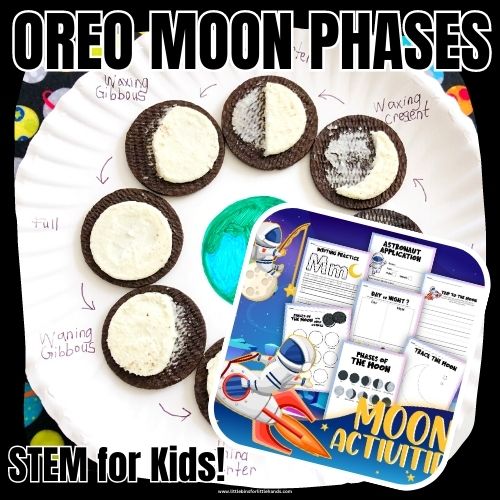
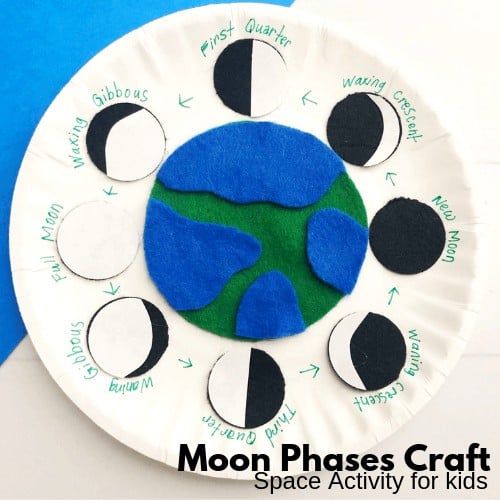
Printable Space Projects Pack
With 250+ pages of hands-on fun space themed fun, you can easily explore classic space themes with your kiddos including moon phases, constellations, the solar system, and of course the 1969 Apollo 11 lunar landing with Neil Armstrong.
⭐️ Activities include supply lists, instructions, and step-by-step pictures. Also Includes FULL Space Camp Week. ⭐️
Celebrate the 1969 lunar landing with easy-to-do activities at home, with groups, at camp, or in the classroom. Read up on this famous event and learn more about Neil Armstrong as well.
- Moon STEAM activities combine science, technology, engineering, art, and math with supply lists, set up and process photos, and science information. Craters, fizzy moon rocks, edible moon phases, watercolor galaxies, a DIY planetarium, bottle rocket, and so MUCH MORE!
- Printable Moon STEM challenges that are simple but engaging for home or classroom. Also included, is a Moon theme STEM Story with challenges perfect for going on a STEM adventure inside or outside!
- Moon phases & Constellation activities include charting moon phases, oreo moon phases, moon phases mini book, and more!
- Solar System activities include a solar system lapbook template and plenty of information to learn about the solar system and beyond!
- Moon extras include I-Spy, algorithm game, binary code project, 3D rocket building, thaumatropes, and MORE!
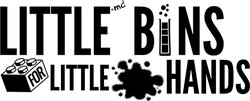

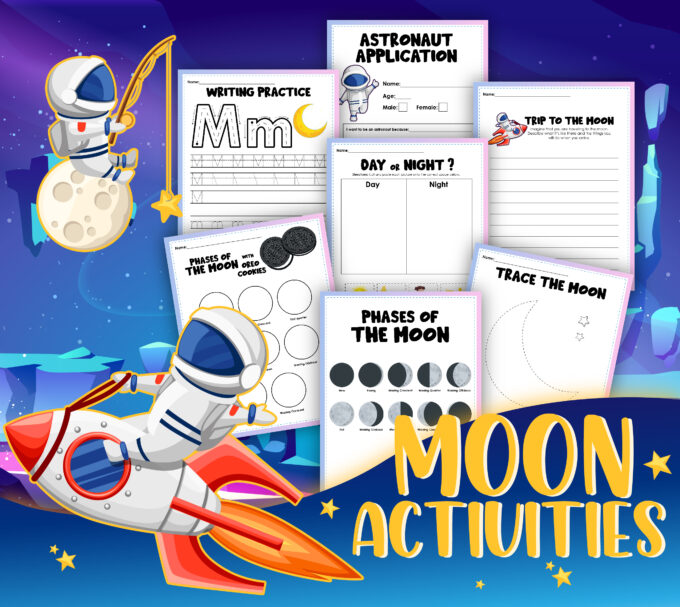

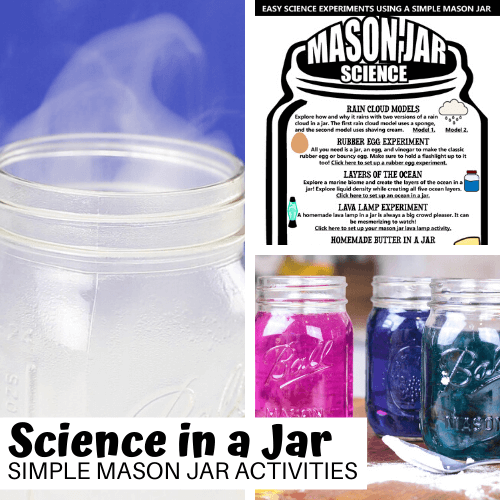

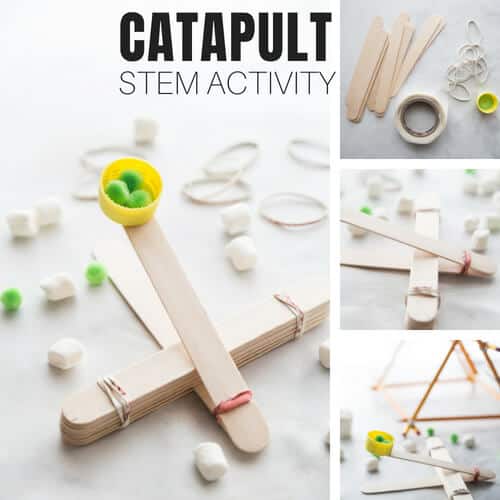
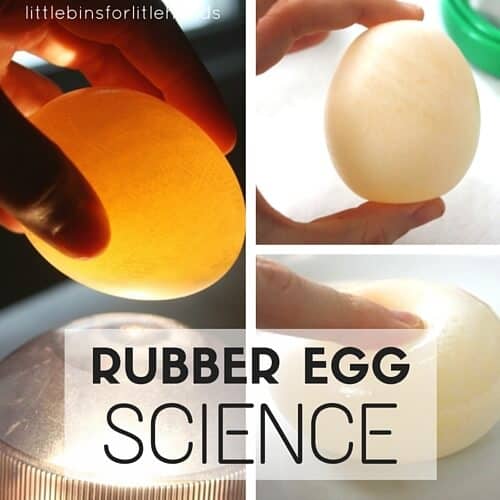
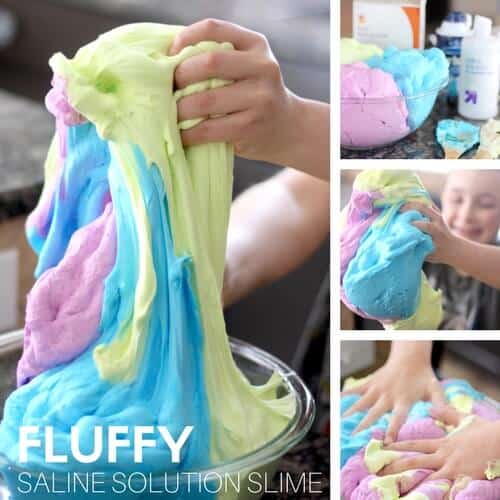
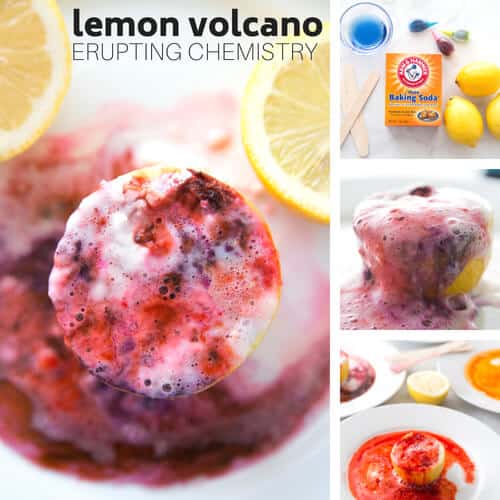
I love this Fizzy Moon Painting, but I wanted to know if I did this in my classroom, how long does it take for the baking soda to dry?
You will probably want to give it overnight but it also depends on how thick the kids apply it too!